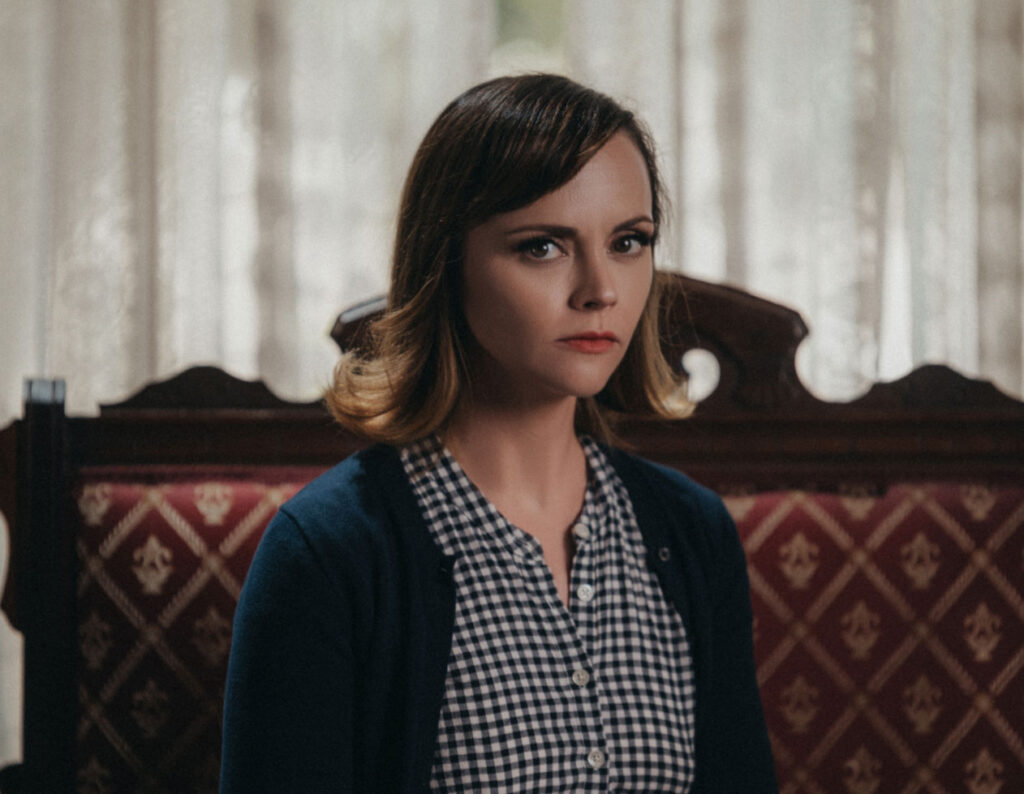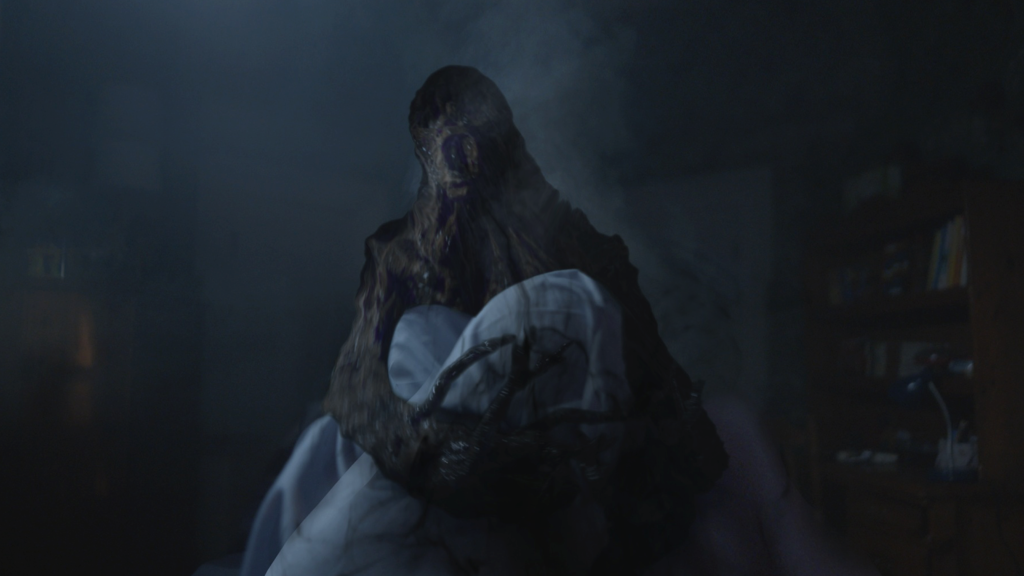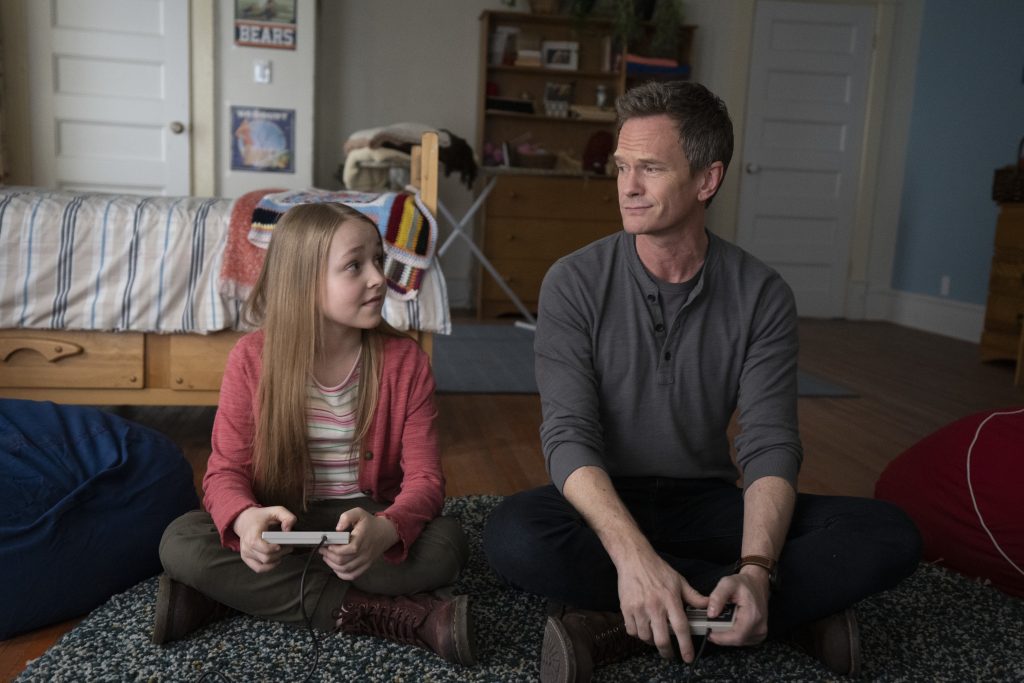July 17, 2022
by Carla Hay

Directed by Chris Sivertson
Culture Representation: Taking place in California, the horror film “Monstrous” has an all-white cast of characters representing the working-class and middle-class.
Culture Clash: A divorced mother moves from Mesa, Arizona, to California, where she and her 7-year-old son start being attacked a ghostly monster that appears to live in a backyard lake.
Culture Audience: “Monstrous” will appeal primarily to people who are fans of star Christina Ricci and anyone who doesn’t mind watching dull haunted house movies that recycle the same old clichés.

The only thing that’s monstrous about the limp and boring horror film “Monstrous” is how it’s a waste of time for viewers and a waste of Christina Ricci’s talent. It’s yet another unimaginative horror flick about a family living in an isolated wooded area while being attacked by an evil spirit. There’s a surprise “reveal” toward the end of the movie which is not shocking at all because viewers can see the very obvious clues long before this plot twist is divulged.
Directed by Chris Sivertson and written by Carol Chrest, “Monstrous” is a poorly conceived misfire from start to finish. The movie appears to take place in the mid-1950s, based on the cars in the movie and the way that Ricci’s lead character Laura Butler dresses and styles her hair. Laura, who is divorced, has secretly moved from Mesa, Arizona, to an unnamed city in California with her 7-year-old son Cody (played by Santino Barnard), a generic horror movie kid whose only purpose is to act wide-eyed and scared. You can almost do a countdown to when Cody starts having nightmares.
Laura and Cody are living in a rental farmhouse in an isolated wooded area near a lake. The house owners are an elderly couple named Mr. Langtree (played by Don Durrell, also known as Don Baldaramos) and his wife Leonora (played by Colleen Camp), who both live not too far from the farmhouse. Mr. Langtree (whose first name is never mentioned in the movie) is a lot friendlier than Leonora, who is cranky and suspicious of Laura. Observant viewers who notice how Leonora talks and how she’s dressed won’t be surprised by the “twist” that comes later in the movie.
Laura starts a new job as a typist/secretary in a 1950s-styled office. There’s really no point to these office scenes except to show that Laura’s co-worker Jane (played by Carol Anne Watts) appeared in a prior nonsensical hallucinatory type scene where Laura imagined herself as a terror victim in a 1950s-styled horror movie. Jane appears in this imaginary horror flick and tells Laura, “Don’t be afraid.”
Why did Laura and Cody abruptly and secretly move to California? It’s because Laura is living in fear of her abusive ex-husband Scott (voiced by Matt Lovell), who is never seen in the movie but is heard on the phone when he makes menacing calls to Laura. Scott’s physical and emotional abuse of Laura, which Cody has witnessed, is the main reason why Laura divorced Scott.
Laura has sole custody of Cody, but Scott has visitation rights. Laura has decided she wants to go into hiding because she doesn’t want Scott to see her and Cody anymore. Somehow, Scott finds out Laura’s new phone number. And when Scott calls her, she’s horrified and hangs up immediately before any conversation can happen.
Soon afterward, Laura’s mother (voiced by Nancy O’Fallon) calls. Laura tells her mother (who doesn’t have a first name in the movie) that Scott called Laura just a few minutes earlier. And then, Laura’s mother admits that she went against Laura’s wishes to keep Laura’s new phone number a secret, and she gave Laura’s new phone number to a few people. Scott could’ve have gotten the phone number from one of those people.
Laura scolds her mother for this breach of trust. And now, Laura fears that Scott might be coming to California for a confrontation. Laura’s mother says to her: “He just wants to talk to you. He feels so bad.”
Laura replies, “I don’t care how he feels. I don’t know how you can speak to him after what he did. You’re supposed to be on our side. Grandma would be!”
The “grandma” Laura is speaking about is the mother of Laura’s mother. “Monstrous” has some tedious flashbacks of Laura remembering her childhood that she spent with her grandmother. (Lola Grace, also known as Lola Grace Holmes, portrays Laura as a child.) These flashbacks are filmed in a hokey way.
For example, the adult Laura is seen sitting in a chair underneath a blanket, which segues to a flashback of Laura as a child sitting underneath a blanket in the attic of her childhood home. Her grandmother (played Rachael Edlow) then approaches Laura, removes the blanket, and then says to Laura, “I thought it was Mrs. Seton’s ghost.”
The purpose of the flashback scenes is to show that Laura’s grandmother had psychic abilities to see ghosts. And maybe Laura does too. When Cody starts having nightmares, he tells her that a female ghost comes out of the backyard lake and attacks him. At first, Laura doesn’t believe Cody until it starts happening to Laura.
Cody wants to go back to Mesa, and he says he’s forgiven his father. However, Laura feels the opposite way. Expect to see some arguing back-and-forth between Laura and Cody over these issues. Oscar-winning “Green Book” co-writer Nick Vallelonga has a small and useless role as a legionnaire who dances with Laura when she goes to a bar to meet new people.
The monster continues to appear at the farmhouse and takes many forms, with none being truly terrifying. Sometimes it looks like a creature with tentacles. Sometimes it looks like a swamp woman. During one laughably bad part of the movie, the monster ends up on the house’s roof, looking like someone in a cheap Halloween costume.
Laura tells the Langtrees about the monster attacks, but these two landlords are skeptical. Leonora insists that Laura probably just saw a raccoon. And then another horror cliché kicks into gear: The woman who’s attacked by an evil spirit is not believed, and people start to think she’s mentally ill and that she’s the one who’s the problem.
Laura has a psychiatrist in Arizona named Dr. Weaver (voiced by Chris Mullinax), whom she calls and asks if she can go back on the medication she was on before she moved to California. He tells her it’s not a good idea. Laura also calls a local Catholic church to report that there’s a demon in her house. A nun named Sister Agnes (voiced by Anjoum Agrama), takes the call, but then hangs up on Laura.
All of it is just so mind-numbingly predictable, as the movie drags on and on with more uninspired scenarios of the monster emerging from the lake and continuing to go after Cody and Laura. “Monstrous” is such a relentlessly dull horror move, the intended jump scares could put people to sleep. Ricci seems to be trying hard to make everything convincing, but she’s stuck in a horror movie that is thoroughly unconvincing at being scary or even the bare minimum of interesting.
The “reveal” in “Monstrous” is quite anti-climactic, but you can tell the “Monstrous” filmmakers thought it would be a clever twist, even though there are many other horror movies that have already done versions of this plot twist. In other words, it’s not clever at all. It just exposes more plot holes in “Monstrous.” Viewers will forget this dreadful movie quicker than you can say “M. Night Shyamalan ripoff.”
Screen Media Films released “Monstrous” in select U.S. cinemas, on digital and VOD on May 13, 2022. The movie was released on Blu-ray and DVD on July 5, 2022.


